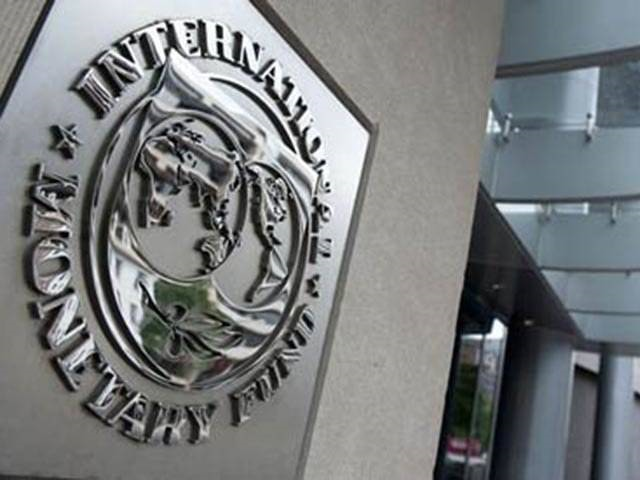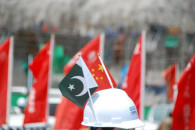Every new govt goes to IMF to manage external account
Data shows current account, trade deficits soar in last year of outgoing govts

PHOTO: AFP/ EXPRESS
During the final year of a government, the balance of payments (BoP) position worsens. Caretakers negotiate a bailout package with the International Monetary Fund (IMF). After the elections, the new government signs an agreement with the multilateral donor as fait accompli, passing the buck to its predecessor.
Thus, periodically Pakistan has to borrow afresh to work off the existing debt. This happened in 2007-08 and 2012-13. This happened twice during the 1990s and this is likely to happen this year as well.
For example, as per the Pakistan Bureau of Statistics (PBS) data, during FY08, the final year of the PML-Q government, the current account deficit shot up to $14.1 billion (8.2% of gross domestic product - GDP) from $6.87 billion (4.8% of GDP) as trade deficit increased to $20.91 billion (12.3% of GDP) from $13.56 billion (8.9% of GDP).
The rupee-dollar parity, which remained relatively stable at about 60 in first four years of the government, increased to 68.3 by the close of FY08. Foreign exchange reserves fell to $11.28 billion at the end of FY08 from $15.18 billion in one year (State Bank of Pakistan data).
In October 2008, a precarious BoP position forced the new government to sign a $7.6-billion loan agreement, which later was enhanced to $11.3 billion, with the IMF.
Likewise, in September 2013, another agreement with the IMF was struck for $6.12-billion assistance by the current PML-N government within three months of taking office.
Risks to Pakistan's economic outlook have increased: IMF
Now let’s look at the present state of the economy. In the first nine months of the current fiscal year (July-March FY18), $12.46-billion current account deficit was registered compared with $8.35 billion recorded in the corresponding period of FY17, a rise of 49.22%.
The current account deficit included $22.30 billion in trade deficit compared with $18.47 billion deficit recorded in July-March FY17, which represented 20.68% growth.
Pakistan’s external debt to climb to $103b by June 2019: IMF report
In its report on Pakistan’s economy released in March 2018, the IMF projected $15.7 billion (4.8% of GDP) of current account deficit for the full financial year. It forecast 10% export growth and 10.2% import growth, which would take exports to $22.46 billion and imports to $58.22 billion, thus resulting in $35.76-billion trade deficit.
However, the July-March FY18 data suggests that the IMF has underestimated the size of current account and trade deficits. Based on GDP growth of 5.8%, as forecast by the government for FY18, the projected GDP size for the outgoing fiscal year is $322.65 billion (FY17 GDP was $304.97 billion).
Government handpicks three candidates for IMF Adviser to Executive Director
Accordingly, at the current growth pace, the current account and trade deficits for FY18 will reach $19.59 billion (6.07% of GDP) and $39.32 billion (12.18% of GDP) respectively.
In FY17, the current account deficit was $13.13 billion or 4.1% of GDP while trade deficit was $32.58 billion or $10.68% of GDP. As per latest data released by the PBS, during FY18 (July-April), exports grew 13.67% to reach $19.2 billion while imports grew 14.04% to reach $49.41 billion, resulting in $30.21-billion trade deficit. At these rates of growth, the FY18 will end up with $37.22-billion trade deficit ($23.42 billion of exports and $60.47 billion of imports), which will account for 11.53% of GDP.
Exchange rate
The worsening current account balance has taken its toll on the exchange rate stability and foreign exchange reserves. After nearly four years of managed exchange rate stability, the government was forced to allow the rupee to depreciate by around five percentage points each in December 2017 and March 2018.
As on May 11, 2018, one US dollar traded for Rs118 in the open market. Liquid foreign currency reserves available with the central bank had gone down to $11.16 billion on May 4, 2018 from $16.14 billion on May 11, 2017, a loss of nearly $5 billion in less than a year.
Conventional economic wisdom, to which the IMF also subscribes, sees a positive relationship between currency depreciation and export increase. However, exports had gone up 10.52% in the first five months (July-November) of the current fiscal year, well before the first depreciation.
The major reason was upward movement of international cotton prices, which has continued into 2018. So it is difficult to state how much the rupee depreciation has contributed, or will contribute, to export increase.
During July-March FY18, the economy received $2.96 billion in foreign direct investment (FDI) and $2.35 billion in foreign portfolio investment (FPI). Compared with the FDI, the FPI is volatile. Outflows may be as quick as inflows. Nevertheless, these non-debt creating instruments eased some pressure on the BoP position.
The government had to rely mainly on debt-creating instruments, such as sale of bonds and commercial loans, on which interest rate is relatively high, to meet the current account deficit. Public external debt, which was $64.48 billion at the close of 2016, had gone up to $73.72 billion at the end of 2017.
In first seven months of FY18, the government borrowed $6.6 billion. In 2018, Pakistan will start repaying the $6.12-billion IMF loan, which would put further pressure on the BoP position.
The FY19 budget has allocated Rs803.98 billion ($7.22 billion at an exchange rate of Rs115 per dollar) for the payment of principal and interest on foreign loans.
A substantial increase in both exports and FDI is the key to reducing the external account deficit. However, this is easier said than done, which forces the government to rely on foreign credit and ultimately knock at the door of the IMF from time to time.
The IMF’s conditionality, which accompanies credit inflows, has also not helped the government in addressing structural constraints to export growth. It seems the multilateral donor is interested more in recovering its loan than in restructuring of the borrowing economy.
A new elected government is likely to take office in August this year. One of the first major decisions it will face will be how to meet the country’s external account obligations. As in the past, signing an agreement with the IMF is likely to be the answer no matter which party forms the government.
The writer is an Islamabad-based columnist
Published in The Express Tribune, May 28th, 2018.
Like Business on Facebook, follow @TribuneBiz on Twitter to stay informed and join in the conversation.

















COMMENTS
Comments are moderated and generally will be posted if they are on-topic and not abusive.
For more information, please see our Comments FAQ